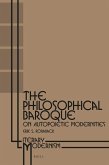Art and Pornography: Philosophical Essays
Herausgeber: Maes, Hans; Levinson, Jerrold
Art and Pornography: Philosophical Essays
Herausgeber: Maes, Hans; Levinson, Jerrold
- Gebundenes Buch
- Merkliste
- Auf die Merkliste
- Bewerten Bewerten
- Teilen
- Produkt teilen
- Produkterinnerung
- Produkterinnerung
Do art and pornography overlap, or are the two mutually exclusive? If they are, why is that? Art and Pornography explores the artistic status and aesthetic dimension of pornographic pictures, films, and literature. A team of leading scholars develops a subtle understanding of sexual imagery and themes, in a range of cultural contexts.
Andere Kunden interessierten sich auch für
![The Wreath of Wild Olive: Play, Liminality, and the Study of Literature The Wreath of Wild Olive: Play, Liminality, and the Study of Literature]() Mihai I. SpariosuThe Wreath of Wild Olive: Play, Liminality, and the Study of Literature100,99 €
Mihai I. SpariosuThe Wreath of Wild Olive: Play, Liminality, and the Study of Literature100,99 €![The Philosophical Baroque: On Autopoietic Modernities The Philosophical Baroque: On Autopoietic Modernities]() Erik S. RorabackThe Philosophical Baroque: On Autopoietic Modernities152,99 €
Erik S. RorabackThe Philosophical Baroque: On Autopoietic Modernities152,99 €![Character: The History of a Cultural Obsession Character: The History of a Cultural Obsession]() Marjorie GarberCharacter: The History of a Cultural Obsession27,99 €
Marjorie GarberCharacter: The History of a Cultural Obsession27,99 €![Moral Philosophy, Or, Ethics And Natural Law Moral Philosophy, Or, Ethics And Natural Law]() Joseph RickabyMoral Philosophy, Or, Ethics And Natural Law39,99 €
Joseph RickabyMoral Philosophy, Or, Ethics And Natural Law39,99 €![Engraving Virtue: The Printing History of a Premodern Korean Moral Primer Engraving Virtue: The Printing History of a Premodern Korean Moral Primer]() Young Kyun OhEngraving Virtue: The Printing History of a Premodern Korean Moral Primer197,99 €
Young Kyun OhEngraving Virtue: The Printing History of a Premodern Korean Moral Primer197,99 €![Historical Traces and Future Pathways of Poststructuralism Historical Traces and Future Pathways of Poststructuralism]() Historical Traces and Future Pathways of Poststructuralism190,99 €
Historical Traces and Future Pathways of Poststructuralism190,99 €![Socrates in Russia Socrates in Russia]() Socrates in Russia184,99 €
Socrates in Russia184,99 €-
-
-
Do art and pornography overlap, or are the two mutually exclusive? If they are, why is that? Art and Pornography explores the artistic status and aesthetic dimension of pornographic pictures, films, and literature. A team of leading scholars develops a subtle understanding of sexual imagery and themes, in a range of cultural contexts.
Produktdetails
- Produktdetails
- Verlag: Oxford University Press, USA
- Seitenzahl: 344
- Erscheinungstermin: 7. Februar 2013
- Englisch
- Abmessung: 241mm x 161mm x 24mm
- Gewicht: 667g
- ISBN-13: 9780199609581
- ISBN-10: 0199609586
- Artikelnr.: 35939080
- Verlag: Oxford University Press, USA
- Seitenzahl: 344
- Erscheinungstermin: 7. Februar 2013
- Englisch
- Abmessung: 241mm x 161mm x 24mm
- Gewicht: 667g
- ISBN-13: 9780199609581
- ISBN-10: 0199609586
- Artikelnr.: 35939080
Hans Maes received his PhD from the University of Leuven, Belgium, and conducted postdoctoral research at the University of Helsinki, Finland, and University of Maryland, USA. He is currently Lecturer in History and Philosophy of Art at the University of Kent and Associate Director of the Aesthetics Research Group. He has authored papers on a variety of subjects in aesthetics, including the role of intention in the interpretation of art, the notion of free beauty, and the relation between art and pornography. In 2010 he was elected President of the Dutch Society for Aesthetics. Jerrold Levinson is Distinguished Professor of Philosophy at the University of Maryland, College Park, where he has taught since 1976. He is the author of Music, Art, and Metaphysics (Cornell University Press, 1990), The Pleasures of Aesthetics (Cornell University Press, 1996), Music in the Moment (Cornell University Press, 1998), L=art, la musique, et l=histoire (Editions de l'eclat, 1998), La musique de film: fiction et narration (Presses Universitaires de Pau, 2000), and Contemplating Art (OUP, 2006), as well as editor of Aesthetics and Ethics (CUP, 1998) and The Oxford Handbook of Aesthetics (OUP, 2003), and co-editor of Aesthetic Concepts (OUP, 2001).
* Introduction
* I. Pornography, Erotica, and Art
* 1: Hans Maes: Who Says Pornography Can't Be Art?
* 2: Alex Neill: The Pornographic, the Erotic, the Charming, and the
Sublime
* 3: David Davies: Pornography, Art, and the Intended Response of the
Receiver
* 4: Jerrold Levinson: Is Pornographic Art Comparable to Religious Art?
Reply to Davies
* II. Pornography, Imagination, and Fiction
* 5: Cain Todd: Imagination, Fantasy, and Sexual Desire
* 6: Kathleen Stock: Pornography and Imagining about Oneself
* 7: Christy Mag Uidhir and Henry John Pratt: Pornography at the Edge:
Depiction, Fiction, and Sexual Predeliction
* III. Pornography, Medium, and Genre
* 8: Petra van Brabandt and Jesse Prinz: Why Do Porn Films Suck
* 9: Bence Nanay: Anti-Pornography: André Kertész's Distortions
* 10: Michael Newall: An Aesthetics of Transgressive Pornography
* IV. Pornography, Ethics, and Feminism
* 11: Brandon Cooke: On the Ethical Distinction Between Art and
Pornography
* 12: Andrew Kania: Concepts of Pornography: Aesthetics, Feminism, and
Methodology
* 13: A. W. Eaton: What's Wrong With The (Female) Nude? A Feminist
Perspective on Art and Pornography
* 14: Elisabeth Schellekens: Taking a Moral Perspective: On Voyeurism
in Art
* Index
* I. Pornography, Erotica, and Art
* 1: Hans Maes: Who Says Pornography Can't Be Art?
* 2: Alex Neill: The Pornographic, the Erotic, the Charming, and the
Sublime
* 3: David Davies: Pornography, Art, and the Intended Response of the
Receiver
* 4: Jerrold Levinson: Is Pornographic Art Comparable to Religious Art?
Reply to Davies
* II. Pornography, Imagination, and Fiction
* 5: Cain Todd: Imagination, Fantasy, and Sexual Desire
* 6: Kathleen Stock: Pornography and Imagining about Oneself
* 7: Christy Mag Uidhir and Henry John Pratt: Pornography at the Edge:
Depiction, Fiction, and Sexual Predeliction
* III. Pornography, Medium, and Genre
* 8: Petra van Brabandt and Jesse Prinz: Why Do Porn Films Suck
* 9: Bence Nanay: Anti-Pornography: André Kertész's Distortions
* 10: Michael Newall: An Aesthetics of Transgressive Pornography
* IV. Pornography, Ethics, and Feminism
* 11: Brandon Cooke: On the Ethical Distinction Between Art and
Pornography
* 12: Andrew Kania: Concepts of Pornography: Aesthetics, Feminism, and
Methodology
* 13: A. W. Eaton: What's Wrong With The (Female) Nude? A Feminist
Perspective on Art and Pornography
* 14: Elisabeth Schellekens: Taking a Moral Perspective: On Voyeurism
in Art
* Index
* Introduction
* I. Pornography, Erotica, and Art
* 1: Hans Maes: Who Says Pornography Can't Be Art?
* 2: Alex Neill: The Pornographic, the Erotic, the Charming, and the
Sublime
* 3: David Davies: Pornography, Art, and the Intended Response of the
Receiver
* 4: Jerrold Levinson: Is Pornographic Art Comparable to Religious Art?
Reply to Davies
* II. Pornography, Imagination, and Fiction
* 5: Cain Todd: Imagination, Fantasy, and Sexual Desire
* 6: Kathleen Stock: Pornography and Imagining about Oneself
* 7: Christy Mag Uidhir and Henry John Pratt: Pornography at the Edge:
Depiction, Fiction, and Sexual Predeliction
* III. Pornography, Medium, and Genre
* 8: Petra van Brabandt and Jesse Prinz: Why Do Porn Films Suck
* 9: Bence Nanay: Anti-Pornography: André Kertész's Distortions
* 10: Michael Newall: An Aesthetics of Transgressive Pornography
* IV. Pornography, Ethics, and Feminism
* 11: Brandon Cooke: On the Ethical Distinction Between Art and
Pornography
* 12: Andrew Kania: Concepts of Pornography: Aesthetics, Feminism, and
Methodology
* 13: A. W. Eaton: What's Wrong With The (Female) Nude? A Feminist
Perspective on Art and Pornography
* 14: Elisabeth Schellekens: Taking a Moral Perspective: On Voyeurism
in Art
* Index
* I. Pornography, Erotica, and Art
* 1: Hans Maes: Who Says Pornography Can't Be Art?
* 2: Alex Neill: The Pornographic, the Erotic, the Charming, and the
Sublime
* 3: David Davies: Pornography, Art, and the Intended Response of the
Receiver
* 4: Jerrold Levinson: Is Pornographic Art Comparable to Religious Art?
Reply to Davies
* II. Pornography, Imagination, and Fiction
* 5: Cain Todd: Imagination, Fantasy, and Sexual Desire
* 6: Kathleen Stock: Pornography and Imagining about Oneself
* 7: Christy Mag Uidhir and Henry John Pratt: Pornography at the Edge:
Depiction, Fiction, and Sexual Predeliction
* III. Pornography, Medium, and Genre
* 8: Petra van Brabandt and Jesse Prinz: Why Do Porn Films Suck
* 9: Bence Nanay: Anti-Pornography: André Kertész's Distortions
* 10: Michael Newall: An Aesthetics of Transgressive Pornography
* IV. Pornography, Ethics, and Feminism
* 11: Brandon Cooke: On the Ethical Distinction Between Art and
Pornography
* 12: Andrew Kania: Concepts of Pornography: Aesthetics, Feminism, and
Methodology
* 13: A. W. Eaton: What's Wrong With The (Female) Nude? A Feminist
Perspective on Art and Pornography
* 14: Elisabeth Schellekens: Taking a Moral Perspective: On Voyeurism
in Art
* Index








